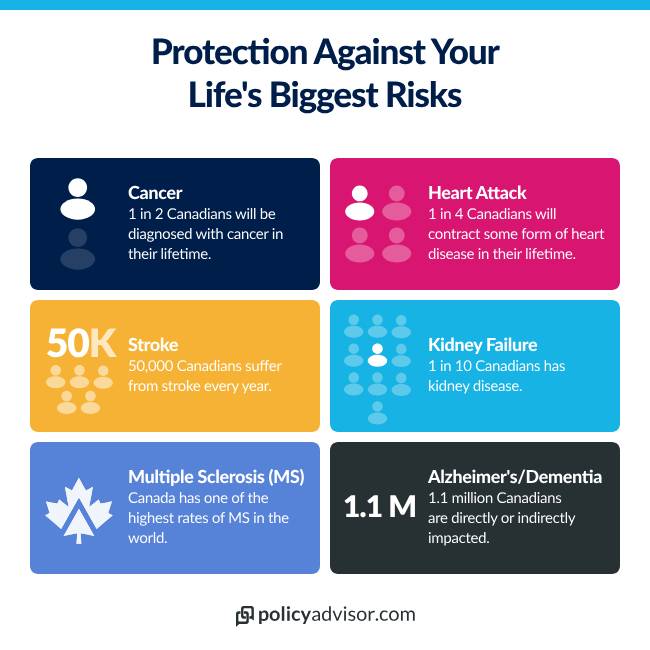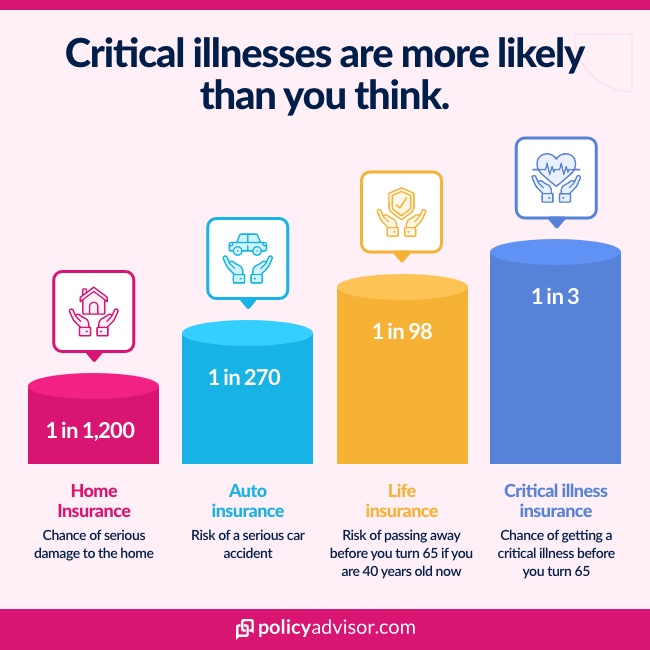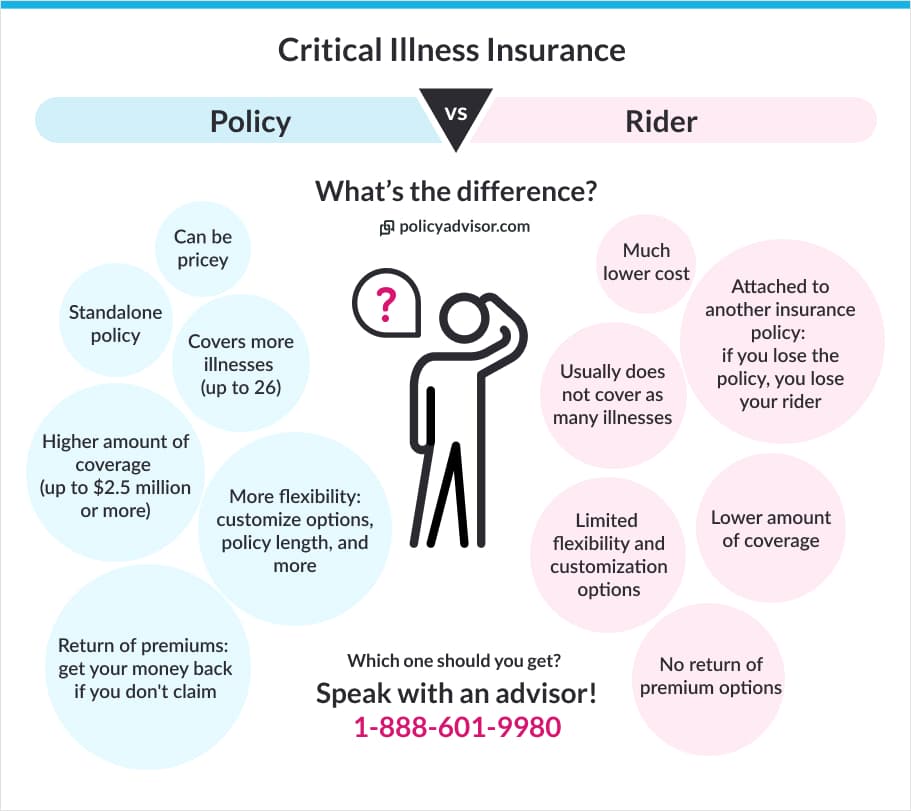A critical illness diagnosis can devastate more than just your health; it can destroy your financial stability. With treatment costs, income loss, and unexpected expenses mounting, families often struggle to maintain their standard of living during recovery. Critical illness insurance provides a crucial financial safety net, offering a lump-sum payment when you need it most.
Whether you’re concerned about family health history, want to protect your mortgage payments, or ensure your family’s financial security, the right critical illness insurance plan provides peace of mind and financial protection.
In this guide, we’ll help you select the best critical illness insurance for your needs, covering costs, coverage options, plan types, and expert buying strategies for 2025.
What is critical illness insurance in Canada?
Critical illness insurance in Canada is a specialized insurance product that pays a tax-free lump sum if you’re diagnosed with a covered serious illness. Unlike health insurance, which covers medical treatments, critical illness insurance gives you cash to use however you choose, whether for medical expenses, mortgage payments, childcare, or taking time off work to recover.
With cancer affecting nearly one in two Canadians and other serious illnesses becoming increasingly common, this insurance provides essential financial protection when traditional health coverage falls short.
Why you need critical illness insurance in Canada
Critical illness can create significant financial hardship beyond medical costs. While Canada’s healthcare system covers many treatments, it does not replace lost income or account for the full range of expenses families face during recovery. This gap leaves many households exposed to serious financial strain at the very moment they need stability the most.
Critical illness insurance provides a tax-free lump sum payment upon diagnosis of a covered condition. This benefit helps offset lost income, pay for non-covered medical expenses, or fund recovery-related costs such as home modifications and caregiving. Importantly, it offers complete flexibility; policyholders can decide how best to use the funds for their situation.
Core reasons to consider coverage
Advances in medicine mean survival rates for conditions like cancer, heart attack, and stroke have improved significantly. However, longer recoveries and added costs put a heavy financial burden on families.
While public healthcare covers hospital and physician services, it does not pay for all rehabilitation, out-of-country care, or income replacement. Critical illness insurance fills that gap by ensuring families have the financial resources to manage these challenges.
What it typically covers
- Major illnesses such as cancer, heart attack, and stroke
- Medical costs not included in provincial healthcare (e.g., private clinics, alternative therapies, out-of-country treatment)
- Recovery-related needs such as home modifications, nursing support, or childcare
Who should consider it
- Working professionals with dependents who rely on their income
- Self-employed individuals or business owners without access to group benefits
- Pre-retirees who want to protect retirement savings from being depleted by illness-related costs
Financial benefits
- Replaces lost income during recovery periods
- Preserves long-term savings such as RRSPs and TFSAs
- Provides support for family members who need to take time off work to provide care
How much does critical illness insurance cost in Canada?
Critical illness insurance in Canada costs between $25–$380 per month in 2025, depending on age, health status, and coverage amount. Here’s a detailed breakdown of costs for $100,000 coverage:
Cost of critical illness insurance in Canada
| Policyholder’s Age | Premium (per month) |
| 25 years | $25 |
| 35 years | $45 |
| 45 years | $75 |
| 55 years | $125 |
| 65 years | $220 |
| 75 years | $380 |
Note: These figures represent average premiums for critical illness insurance with $100,000 coverage for non-smokers in good health.
Step-by-step guide: How to buy critical illness insurance
Critical illness insurance is a valuable financial tool that provides a tax-free lump sum payment if you’re diagnosed with a specified serious illness and survive a specified period (often 30 days). This payout can help cover living expenses, medical costs not covered by provincial health plans, or allow you to take time off work to focus on recovery.
- Eligibility for critical illness insurance generally depends on your age, health, and the coverage amount requested. Insurers typically ask about personal and family medical history and lifestyle factors. Some applicants may require a medical exam or physician statement
- Policy selection often involves choosing between more comprehensive or basic coverage options based on your budget and personal risk profile. More extensive plans may include a broader list of covered illnesses and optional riders (such as return-of-premium)
- Working with our licensed insurance advisors can be extremely helpful for comparing policies from multiple insurers, understanding any exclusions, and identifying the best option for your specific situation
What to expect during the critical illness insurance application
You’ll complete an application form, answering questions about your medical history, lifestyle, and possibly consenting to medical record review. Depending on the insurer and the amount of coverage requested, the insurer may request a paramedical exam or further information from your physician.
Once underwriting is complete and the policy is approved, you’ll receive a contract outlining the covered illnesses, survival period, exclusions, benefit amount, and any optional riders. If you are diagnosed with a covered condition and survive the required waiting period (often 30 days, though it can vary by insurer and condition), the insurer will pay out the lump-sum benefit.
There is often a free-look period after you receive the policy contract, during which you can cancel coverage for a full refund of premiums paid.
What happens when you apply for critical illness insurance
- Some applicants may qualify without needing a medical exam if they are young, in good health, and request a basic level of coverage
- Others, for example, those with a family history of serious illness, may face higher premiums, exclusions, or a longer underwriting process. In some cases, insurers may offer modified coverage or deny coverage for certain illnesses
Read more about when you should purchase critical illness insurance
Policy features you must be aware of
- Survival period: Most policies require that you survive for a specific number of days after diagnosis before the lump-sum is payable. Thirty days is common, though some policies require longer for specific illnesses
- Partial or early-stage benefits: Some policies offer partial payouts for early-stage or less severe versions of covered illnesses, but only if the diagnosis meets the policy’s definitions
- Policy definitions: Each illness is defined in the policy, and benefits are only paid if the diagnosis meets those definitions
- Policy term versus renewable or lifetime coverage: Some policies are term-based (e.g. 10 or 20 years), while others provide coverage up to a specified age or even for life. Reviewing the term and renewal options is important
Tips from our PolicyAdvisor experts for a more informed decision
- If possible, apply while you’re young and healthy, since premiums tend to be lower and you’re more likely to qualify for broader coverage
- Think ahead: your coverage needs may change after major life events (e.g. marriage, having children, starting a business), so consider policies that allow for future adjustments
- Compare not just cost but also the number of covered conditions, optional riders, survival period, and claim definitions
- Consider bundling critical illness insurance with life or disability insurance for broader income and financial protection and potentially lower total cost
How to get cheap critical illness insurance?
Securing affordable critical illness insurance isn’t about finding the cheapest critical illness insurance policy; it’s about striking the right balance between cost and meaningful protection.
Insurers evaluate risk based on age, health, and lifestyle, so knowing how these factors work gives you an edge. With the right strategy, you can lock in lower rates while still protecting your long-term financial security.
Apply early, while you’re healthy
Time is your biggest advantage. Age is the number one driver of premiums: a 25-year-old may pay around $25/month for $100,000 of coverage, while a 55-year-old could pay closer to $125/month for the same benefit. Applying young not only locks in lower premiums but also makes it easier to qualify for term policies without exclusions or surcharges.
Build a healthy profile
Insurers literally price health into your policy. The healthier your profile, the more affordable your coverage:
- Non-smokers typically save 40–60% compared to smokers
- Regular exercise can help you qualify for preferred health classes
- Maintaining a healthy BMI (18.5–24.9) supports standard or better pricing
- Avoiding high-risk hobbies (skydiving, scuba diving) keeps extra fees off your file
In short, the lifestyle choices you make today directly shape the price you’ll pay tomorrow.
Customize your coverage to real needs
The most effective strategy is to purchase coverage that aligns with your actual needs, rather than the maximum available. Consider:
- Income replacement: 3–5× annual salary
- Debt coverage: enough to pay off your mortgage and loans
- Family needs: daycare, tuition, or a partner’s reduced income
- Recovery time: planning for 1–3 years of financial breathing room
This approach ensures you’re protected without overspending on unnecessary coverage.
Understand term vs. permanent insurance
For most Canadians under 50, term coverage offers the most value:
- Term 20 or 30 protects your prime working years affordably.
- Conversion options let you upgrade to permanent coverage later without another medical exam.
- Return-of-premium riders can refund premiums if you stay healthy, though they increase costs. This is the best for those who prioritize premium protection.
Leverage licensed brokers for choice and savings
Working with a licensed broker like PolicyAdvisor gives you access to multiple insurers and insider expertise:
- Compare rates from 10+ providers at once
- Understand how different insurers view your health conditions
- Navigate underwriting smoothly to avoid delays
- Explore group or association discounts not available directly
This can mean hundreds or even thousands in savings over the life of your policy.
Time your application wisely
When you apply, matters almost as much as what you buy. The best times include:
- After resolving temporary health concerns (like high blood pressure)
- Before scheduled surgeries or treatments that could trigger exclusions
- During open enrollment windows with group coverage
- When your budget is stable, so premiums are affordable long-term
Coverage for pre-existing medical conditions
Understanding how pre-existing conditions affect critical illness insurance is crucial for obtaining adequate protection and avoiding claim denials. When applying for critical illness insurance, the insurer evaluates the applicant’s medical history. If a client has a history of a serious illness (e.g., cancer, heart disease, or stroke), they may:
- Be declined coverage entirely
- Be offered a policy with exclusions for specific conditions
- Be approved with a higher premium due to increased risk
For example, a client who had a heart attack five years ago may be declined for coverage related to cardiovascular conditions but could still be eligible for coverage on other illnesses like cancer or Parkinson’s disease.
Exclusions for pre-existing conditions
Most critical illness policies include a pre-existing condition exclusion clause. This means that if the insured is diagnosed with a covered illness that is linked to a condition they had before the policy was issued, the claim may be denied.
Common exclusion scenarios include:
- The insured had symptoms or received treatment for a condition before the policy start date
- The condition was not disclosed during the application process
- The illness is deemed to be a progression or recurrence of a pre-existing condition
Some policies define a specific look-back period (e.g., 24 months) during which any related medical history may trigger an exclusion.
Underwriting considerations
Underwriting for critical illness insurance is more stringent than for life insurance. It typically involves:
- A detailed health questionnaire
- Review of medical records
- Possible paramedical exams or physician reports
Underwriters assess:
- The type and severity of the pre-existing condition
- Time since diagnosis or last treatment
- Stability of the condition (e.g., no recurrence or symptoms for a certain period)
For example, a client with a history of successfully treated skin cancer may be approved if there has been no recurrence for several years.
Policy limitations
Even if coverage is granted, there may be limitations such as:
- Condition-specific exclusions: The policy may exclude claims for illnesses related to the pre-existing condition.
- Waiting periods: Some policies impose a waiting period (e.g., 90 days) before coverage for certain conditions begins.
- Partial payouts: For some conditions, like coronary angioplasty, only a partial benefit may be payable.
Employer vs. individual critical illness insurance in Canada
Finding affordable critical illness insurance is not just about shopping for the lowest premium. It requires a thoughtful approach that considers your age, health, coverage needs, and whether you already have partial protection through an employer.
For example, an employee with $15,000 in group coverage who is later diagnosed with cancer may find that payout useful for immediate costs but insufficient for travel expenses or income replacement.
Similarly, an employee nearing retirement who only has group coverage risks losing all protection once they leave the workforce. In each of these scenarios, an individual critical illness policy ensures lasting, comprehensive protection that bridges coverage gaps and adapts to life stages.
Here’s a side-by-side comparison to help you decide which option fits your protection needs best:
Group vs individual critical illness insurance
| Feature | Employer-Sponsored Plan | Individual Plan |
| Coverage Amount | Limited, often $10,000–$25,000 | Flexible; can select higher amounts ($25,000–$1M+) |
| Eligibility | Must be employed, sometimes with minimum hours | Open to anyone who qualifies through underwriting |
| Medical Underwriting | Typically none or simplified | Full underwriting (health history, exams) |
| Portability | Ends with employment unless convertible | Fully portable; remains active with premiums paid |
| Cost | Lower or subsidized by employer; not customizable | Higher cost but tailored to needs and budget |
| Coverage Customization | Limited options, one-size-fits-all | Highly customizable (amount, riders, duration) |
| Claim Process | Managed through employer’s group insurer | Direct with insurer; more personalized support |
| Taxation of Benefit | Tax-free if premiums are employee-paid | Tax-free benefit |
| Renewability | Not guaranteed; tied to employer’s plan | Guaranteed renewable (depending on policy type) |
Should you supplement group coverage?
For most Canadians, the ideal strategy combines both:
- Keep group coverage for basic, affordable protection
- Add individual coverage to reach adequate total protection (3–5 times income)
- Ensure portability with individual policy for job security
- Fill coverage gaps that group plans don’t address
For example, If you earn $80,000 annually and have $100,000 group coverage, consider adding $200,000–$300,000 individual coverage to reach recommended protection levels.
Which are the best critical illness insurance providers in Canada?
Leading insurers like Manulife, Canada Life, Sun Life, Equitable Life, and BMO Insurance provide a wide range of policies designed to cover these risks, each with its own strengths in condition coverage, pricing, and flexibility.
Through PolicyAdvisor, Canadians can compare these top providers side by side, access expert guidance, and find a plan that fits their health and financial needs. Unlike going directly to one insurer, PolicyAdvisor gives you the full market view — making it easier to secure the right protection at the right price.
Top critical illness insurance providers in Canada:
- Manulife: Manulife’s Lifecheque is one of the most recognized critical illness products in Canada. It covers over 24 conditions, including cancer, heart attack, and stroke, with options for partial payouts on early-stage diagnoses. The plan includes return of premium features, child riders, and multi-condition coverage. Manulife is valued for its strong brand reputation, financial stability, and streamlined claims support.
- Canada Life: Canada Life offers both standalone and rider-based critical illness coverage. Its policies cover more than 25 conditions and provide optional early detection riders. A key feature is the “Recovery Benefit,” which helps clients during their post-diagnosis phase. With strong underwriting support and responsive claims service, Canada Life is a good choice for clients seeking comprehensive yet cost-effective coverage.
- Sun Life: Sun Life’s critical illness insurance is known for its integration of health and wellness tools alongside financial protection. It covers 26 or more conditions, includes return of premium options, and provides access to health navigation services and second medical opinions. Sun Life is a suitable fit for clients who value both broad coverage and ongoing health management support.
- Equitable Life: Equitable Life’s EquiLiving product is widely regarded by advisors for its affordability and simplicity. It covers over 25 conditions and offers partial payouts for early-stage illnesses. Clients benefit from competitive pricing, flexible return of premium options, and quick claims processing. The product is particularly attractive for those who want straightforward, cost-effective protection.
- BMO Insurance: BMO provides a simplified critical illness product designed for accessibility and speed. It covers more than 24 conditions, offers optional return of premium, and features a digital-first application and claims process. With streamlined underwriting, BMO is especially appealing to younger clients or those purchasing critical illness insurance for the first time.
Frequently asked questions
Is critical illness insurance worth it in Canada?
Critical illness insurance is worth considering if you have dependents, significant debts, or limited disability coverage through your employer. With cancer affecting nearly one in two Canadians and recovery often requiring extended time off work, the lump-sum benefit can provide crucial financial stability during treatment and recovery.
What critical illnesses are typically covered?
Most plans cover 20–25+ conditions including cancer, heart attack, stroke, kidney failure, major organ transplants, multiple sclerosis, Parkinson’s disease, paralysis, blindness, deafness, and severe burns. Coverage definitions vary between insurers, so review specific policy terms carefully.
Can I buy critical illness insurance if I have health conditions?
Yes, but pre-existing conditions may be excluded or require extended waiting periods. Some insurers offer simplified underwriting for certain conditions, while others may decline coverage or charge higher premiums. Working with a broker helps identify insurers most likely to provide favourable terms.
How much critical illness insurance do I need?
Most experts recommend 3–5 times your annual income, or enough to cover your mortgage and major debts plus 2–3 years of living expenses. Consider your family’s financial obligations, available savings, and other insurance coverage when determining appropriate amounts.
Can I cancel my critical illness insurance?
Yes, most policies include a 10-day free-look period for full refunds. After that, you can cancel anytime, though term policies typically have no cash value. Return-of-premium policies may provide partial refunds based on premiums paid and policy duration.







